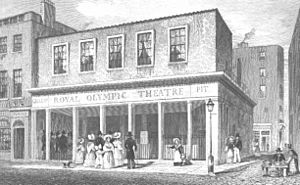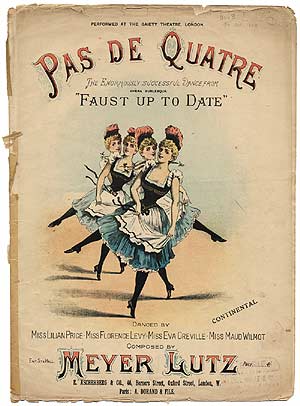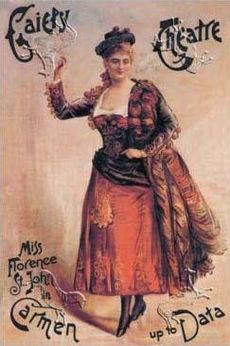Victorian burlesque facts for kids
Victorian burlesque was a fun type of theatre show popular in Victorian England and New York in the mid-1800s. It was also called travesty or extravaganza.
Imagine a famous opera, play, or ballet. Victorian burlesque would take that serious story and turn it into a silly, funny play, often with music. It would make fun of the original show's style and music, sometimes even using parts of its text or tunes. It's one of many kinds of burlesque entertainment.
These shows used lots of different music, from popular songs of the time to opera tunes. Dance was a big part of the show, and the costumes and stage designs were often very grand and eye-catching. A common feature was actresses playing male roles (called breeches roles), which allowed them to wear tights and show their legs. Sometimes, male actors would play older female roles for laughs.
At first, burlesques were short, one-act plays. But later, they grew into full-length shows that took up a whole evening. Famous writers who created burlesques included J. R. Planché, H. J. Byron, G. R. Sims, F. C. Burnand, W. S. Gilbert, and Fred Leslie.
Contents
What is Victorian Burlesque?
Burlesque theatre became popular around the start of the Victorian era. The word "burlesque" comes from the Italian word burla, which means "ridicule" or "mockery."
Victorian burlesque was similar to pantomime (a type of musical play, often based on fairy tales, popular in Britain). It also had roots in ballad opera, where new words were written to existing songs.
In 1831, a theatre manager named Madame Vestris started producing burlesques at the Olympic Theatre. Her first show was Olympic Revels by J. R. Planché. The humor came from how silly it looked to have grand, classical characters in historical costumes doing everyday modern things. For example, Olympic Revels started with the gods of Olympus, dressed in ancient Greek clothes, playing cards!
Early burlesques used popular songs with new, funny lyrics. Later, Victorian burlesque mixed in elements of operetta (a light opera), music hall (variety shows), and revue (a show with songs, dances, and skits). Some of the bigger, more spectacular burlesques were called extravaganzas.
Who Enjoyed Burlesque Shows?
Unlike pantomime, which was for everyone, burlesque was mostly for people who enjoyed clever jokes and knew a lot about theatre and opera. Some writers aimed for middle-class audiences, while others, like H. J. Byron, were very good at appealing to the lower middle classes.
Many burlesques made fun of Shakespeare's plays and famous operas. From the 1850s, burlesques of Italian, French, and German operas were very popular in London. For example, when Verdi's operas Il trovatore and La traviata came to Britain in 1855 and 1856, burlesques of them quickly followed! There were even five different burlesque versions of Il trovatore.
By the 1880s, almost every popular opera had a burlesque version. These shows were often performed for a month or more in local theatres. They were popular because they entertained many different kinds of people and added to the lively, fun atmosphere of Victorian London.
W. S. Gilbert (who later became famous for the Gilbert and Sullivan operas) wrote five opera burlesques early in his career. One of his most successful was Robert the Devil (1868). In the 1870s, Lydia Thompson's burlesque group, with Willie Edouin, became very famous for their burlesques in both Britain and the U.S.
Even Shakespeare's plays were often made fun of. A typical Victorian Shakespeare burlesque would take a play and turn it into a comedy, often changing the story completely. For example, in one burlesque of Macbeth, Macbeth and Banquo enter under an umbrella. When the witches greet them with "Hail! hail! hail!", Macbeth asks what it means, and Banquo replies, "These showers of 'Hail' anticipate your 'reign'" (a pun on "rain" and "reign").
The dialogue in burlesques was usually written in rhyming lines, often with lots of silly puns. For instance, in Faust up to Date (1888), a character says:
- Mephistopheles: "Along the Riviera dudes her praises sing."
- Walerlie: "Oh, did you Riviera such a thing?"
Even though these shows featured women in tights, they were not usually considered inappropriate. W. S. Gilbert himself believed that good burlesque required great skill and could be a true art form, just like the works of famous satirists and cartoonists.
The Gaiety Theatre and Burlesque
Burlesque became a special type of show at London's Royal Strand Theatre and Gaiety Theatre from the 1860s to the early 1890s. In the 1860s and 1870s, burlesques were often short, less than an hour long, and used parodies of popular songs and opera tunes that the audience would know.
Nellie Farren was a famous actress at the Gaiety Theatre, known for playing the "principal boy" (a young male role played by a woman) from 1868. John D'Auban created the dances for the burlesques there. Early Gaiety burlesques included Robert the Devil (1868), The Bohemian G-yurl and the Unapproachable Pole (1877), and Faust up to Date (1888).
In the 1880s, when comedian-writer Fred Leslie joined the Gaiety, composers like Meyer Lutz and Osmond Carr started writing original music for the burlesques. These shows became longer, often two or three acts. Farren and Leslie starred in these later Gaiety burlesques, which included Little Jack Sheppard (1885), Monte Cristo Jr. (1886), and Carmen up to Data (1890). The titles often included puns, like Ruy Blas and the Blasé Roué (1889), which made fun of a play by Victor Hugo. The funnier the pun, the more the audience loved it!
In the early 1890s, Nellie Farren retired, and Fred Leslie passed away. Musical burlesque then went out of style in London. The Gaiety and other theatres started focusing on a new type of show called Edwardian musical comedy. In 1896, a theatre producer named Seymour Hicks said that burlesque was "dead as a doornail and will never be revived."
See also
- Extravaganza
- Parody
- Pastiche
- Travesti (theatre)




